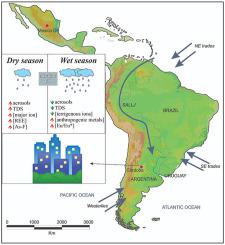Chemosphere ( IF 8.1 ) Pub Date : 2021-09-21 , DOI: 10.1016/j.chemosphere.2021.132307 M G Garcia 1 , K L Lecomte 1 , P J Depetris 2

|
The chemistry of rainwater is controlled by the interaction among water, airborne particles and gas sources, whether natural or human-made. This article analyzes the chemical composition dynamics of individual rainfall events collected over a three-year period in the densely populated city of Córdoba (Argentina). The main purpose is to identify the natural and/or anthropogenic sources, and the extent to which they determine the seasonal chemical signature exhibited by wet precipitation in the heart of the South Eastern South America. The results reveal that, despite geogenic components are only minor constituents of the airborne particles in downtown Córdoba, they appear to be the main source of solutes in rainwaters, also responsible for the alkaline water pH that predominates most of the year. This fraction mostly corresponds to wind-blown soil particles transported either from local or distant sources, with rare earth elements (REE) patterns similar to those of rainwaters produced during the dry season. Anthropogenic contributions are only evident during the wet season, when rainwater shows REE patterns similar to those of industrial emissions and exhibits moderate enrichment of heavy metals such as Cu and Zn, derived from soluble compounds used in agricultural activities (e.g, sowing, fertilizing). With the exception of these two metals, the remaining heavy metals are depleted in rainwater suggesting that the airborne conveying compounds (mostly anthropogenic) are barely soluble.
中文翻译:

南美洲南部人口稠密城市湿降水中溶质的自然和人为来源
雨水的化学性质受水、空气中颗粒和气体源(无论是天然的还是人造的)之间的相互作用的控制。本文分析了在人口稠密的科尔多瓦市(阿根廷)三年内收集的个别降雨事件的化学成分动态。主要目的是确定自然和/或人为来源,以及它们确定南美洲东南部中心地带湿降水表现出的季节性化学特征的程度。结果表明,尽管地质成分只是科尔多瓦市中心空气中颗粒的次要成分,但它们似乎是雨水中溶质的主要来源,也是一年中大部分时间占主导地位的碱性水 pH 值的原因。该部分主要对应于从当地或远处来源运输的风吹土壤颗粒,其稀土元素 (REE) 模式类似于旱季产生的雨水。人为贡献仅在雨季才明显,此时雨水显示出与工业排放相似的稀土元素模式,并表现出适度富集的重金属,如来自农业活动(例如播种、施肥)中使用的可溶性化合物的铜和锌。除了这两种金属外,其余的重金属都在雨水中耗尽,这表明空气中的输送化合物(主要是人为的)几乎不溶解。具有与旱季产生的雨水相似的稀土元素 (REE) 模式。人为贡献仅在雨季才明显,此时雨水显示出与工业排放相似的稀土元素模式,并表现出适度富集的重金属,如来自农业活动(例如播种、施肥)中使用的可溶性化合物的铜和锌。除了这两种金属外,其余的重金属都在雨水中耗尽,这表明空气中的输送化合物(主要是人为的)几乎不溶解。具有与旱季产生的雨水相似的稀土元素 (REE) 模式。人为贡献仅在雨季才明显,此时雨水显示出与工业排放相似的稀土元素模式,并表现出适度富集的重金属,如来自农业活动(例如播种、施肥)中使用的可溶性化合物的铜和锌。除了这两种金属外,其余的重金属都在雨水中耗尽,这表明空气中的输送化合物(主要是人为的)几乎不溶解。来源于农业活动(如播种、施肥)中使用的可溶性化合物。除了这两种金属外,其余的重金属都在雨水中耗尽,这表明空气中的输送化合物(主要是人为的)几乎不溶解。来源于农业活动(如播种、施肥)中使用的可溶性化合物。除了这两种金属外,其余的重金属都在雨水中耗尽,这表明空气中的输送化合物(主要是人为的)几乎不溶解。











































 京公网安备 11010802027423号
京公网安备 11010802027423号